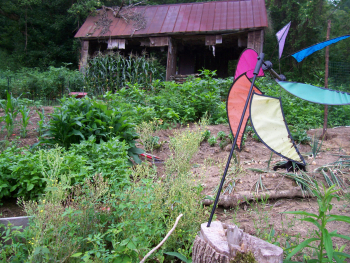
Planting for a Four Season Harvest, Part 8
Harvesting in
June Before Summer Has Begun
 By the calendar, summer has
not yet begun. What am I harvesting
in June? Not many things, but plenty of each kind.
Asparagus still, peas every day, also lettuce, radishes, beet and
turnip greens, scallions, baby carrots. One may tire of stored
canned peas every day or store-bought asparagus, but garden-fresh
vegetables keep the appetite from getting jaded. In winter, I
look forward to the June harvest --- which includes strawberries --- as
the finest of the year.
By the calendar, summer has
not yet begun. What am I harvesting
in June? Not many things, but plenty of each kind.
Asparagus still, peas every day, also lettuce, radishes, beet and
turnip greens, scallions, baby carrots. One may tire of stored
canned peas every day or store-bought asparagus, but garden-fresh
vegetables keep the appetite from getting jaded. In winter, I
look forward to the June harvest --- which includes strawberries --- as
the finest of the year.
In July, the harvest gets
bountiful and varied. The first bush
beans --- immediately I sow more. The first summer squash ---
usually I sow a few more hills. When the latter mature, I pull up
first plants since vines are more likely to be insect-ridden. The
corn
ripens. I may plant more, but not always. I fill the space
left
vacant by pulled-up pea vines by putting out Brussels sprouts,
cauliflower, fennel, and leeks.
Other July crops ready to
be harvested include peas and carrots, and chard wich can be cut again
and again. The first tomatoes, onions, broccoli, cabbage, and
cauliflower, all-spring-planted, have matured.
In any one summer day,
there should be 6 to 8 vegetables ready to eat. That doesn't mean
that every
vegetable is at the peak of perfection on that day, as a non-gardener
is likely to expect. Succession planting could provide ripe corn
and
beans continuously through summer and fall, but it would take too much
space if you wanted other crops, and there'd be waste, even with
canning or freezing. Many vegetables can be used at various
stages ---
don't have to be mature. So long as there is plenty of variety, a
garden is effective.
To be continued....
Tirrell, R. 1966, February. Planting for a 4-Season
Harvest. Organic Gardening and
Farming.
Reprinted by permission of Organic Gardening magazine. Copyright
Rodale, Inc., U.S.A. All rights reserved.
www.organicgardening.com.
Want more in-depth information? Browse through our books.
Or explore more posts by date or by subject.
About us: Anna Hess and Mark Hamilton spent over a decade living self-sufficiently in the mountains of Virginia before moving north to start over from scratch in the foothills of Ohio. They've experimented with permaculture, no-till gardening, trailersteading, home-based microbusinesses and much more, writing about their adventures in both blogs and books.
Want to be notified when new comments are posted on this page? Click on the RSS button after you add a comment to subscribe to the comment feed, or simply check the box beside "email replies to me" while writing your comment.
